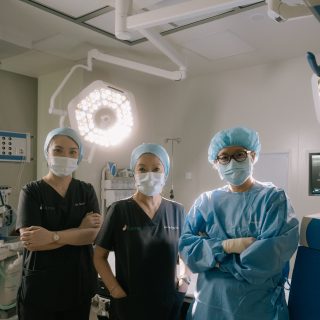Breast cancer is the most common cancer among women in Singapore with over 2,000 women diagnosed each year. According to the Singapore Cancer Registry Annual Report 2018, the incidences of breast cancer are highest in women aged between 40 and 69 years old.
What are some of the symptoms and risk factors, and how can we prevent breast cancer?
The most common type of breast cancer originates from the cells lining the milk ducts and glands[1]. When abnormal cells are detected in the milk ducts and have not spread to other parts of the breast or the rest of the body, this is termed as Ductal Carcinoma In-Situ (DCIS). Patients with DCIS have a greater chance of recovering. Breast cancer may also begin in the glandular tissue called lobules or in other cells or tissue within the breast.
The importance of early detection and regular breast cancer screening
Going for regular breast cancer screening is important because it catches breast changes early before symptoms (such as a lump that can be felt) develop. Breast cancer is most treatable when it is detected and diagnosed at an early stage. Identifying the disease during its initial growth can mean that the required treatments are simpler and more effective. The earlier the breast cancer is detected, the smaller the tumour may be and the less likely it would have spread to other parts of your body or the lymph nodes.
Breast cancer symptoms
Symptoms may vary for different people and some of these symptoms may be related to other conditions that are not due to cancer. It is best to speak to your doctor or breast cancer specialist if you have any of these symptoms.
Some symptoms of breast cancer may include:
- Lump in the breast or underarm area
- Thickening or swelling of part of the breast
- Irritation or dimpling of the skin on the breast
- A rash or flaky skin in the nipple area or the breast
- Pain or discomfort around the nipple or in the surrounding area; or the nipple being pulled inward
- Nipple discharge other than breast milk, including blood
- Change in the size or the shape of the breast
- Pain or discomfort in the breast
How is breast cancer diagnosed?
Your healthcare professional or breast cancer specialist may conduct one or more of the following test(s) or procedure(s) to diagnose breast cancer:
- Physical examination. Your doctor or breast cancer specialist will examine both of your breasts and lymph nodes in your armpit to detect any lumps or other abnormalities.
- Breast mammogram. Mammograms, which is an X-ray of the breast are commonly used to screen for breast cancer. Your breast cancer specialist may recommend a diagnostic mammogram to evaluate any abnormality that is detected on a screening mammogram.
- Breast ultrasound. Breast ultrasound, which is more commonly used in younger women can be used to determine whether a new breast lump is a solid mass or a fluid-filled cyst.
- Breast magnetic resonance imaging (MRI). A breast MRI is a contrast-enhanced machine that uses strong magnets to create cross-sectional images of the breast.
Confirmation of breast cancer
Removing a sample of breast cells for testing (biopsy). A biopsy, where a sample of breast cells is removed for testing, is the definitive way to make a diagnosis of breast cancer. During a biopsy[2], your breast cancer specialist will use a specialised needle device to extract a core tissue from the suspicious area. Biopsy samples will be sent to a laboratory for analysis to determine whether the cells are cancerous. The pathologist will also analyse the biopsy sample to determine the type of cells involved in the breast cancer, the aggressiveness of the cancer, and whether the cancer cells have hormone receptors or other receptors that may influence your treatment options.
Risk factors for Breast Cancer
Leading a sedentary lifestyle or being overweight after menopause can increase your risk of getting breast cancer. Some hormone replacement therapy[3] especially those that include both estrogen and progesterone taken during menopause may also increase the risk for breast cancer if taken for more than five years. Drinking excessive alcohol and having your pregnancy after age 30 may also increase a woman’s risk of breast cancer3.
The risk for breast cancer also increases with age. Most breast cancers are diagnosed after age 40[4]. A woman’s risk for breast cancer is also higher if a first-degree relative or multiple family members on the parents’ side[5] have had breast or ovarian cancer.
How to prevent breast cancer
Apart from regular breast screening, research shows that lifestyle changes can decrease the risk of breast cancer, even among women who are at high risk. Here are some lifestyle strategies that you can use to reduce your risk[6]:
- Cut down on your consumption of alcohol as this can reduce your risk of developing breast cancer. The general recommendation is to limit yourself to no more than one drink a day.
- Maintain a healthy body weight. Cut down on your daily calorie intake and try to incorporate some daily physical activity such as taking a walk, alighting one stop before your destination, doing housework or climbing the stairs.
- Breast-feeding may also play a role in breast cancer prevention. The protective effect is enhanced if you breast feed for a longer period.
- Limit postmenopausal hormone therapy. Talk to your doctor about the risks and benefits of hormone therapy as you might be able to manage your symptoms with nonhormonal therapies and medications.
- Eating a healthy diet might decrease your risk of some types of cancer including breast cancer. Try to consume more plant-based foods, such as fruits and vegetables, whole grains, legumes, and nuts. Cut down on red meat and choose healthy fats, such as olive oil and eat more oily fish such as tuna, salmon and mackerel.
References:
[1]Singapore Cancer Society, Breast Cancer
[2]American Cancer Society, Breast Cancer Early Detection and Diagnosis
[3]Centre for Disease Control & Prevention, What Are the Risk Factors for Breast Cancer?
[4]Singapore Cancer Registry Annual Report 2020
[5]Centre for Disease Control & Prevention, What Can I Do to Reduce My Risk of Breast Cancer?
[6]Mayo Clinic, Breast cancer prevention: How to reduce your risk




